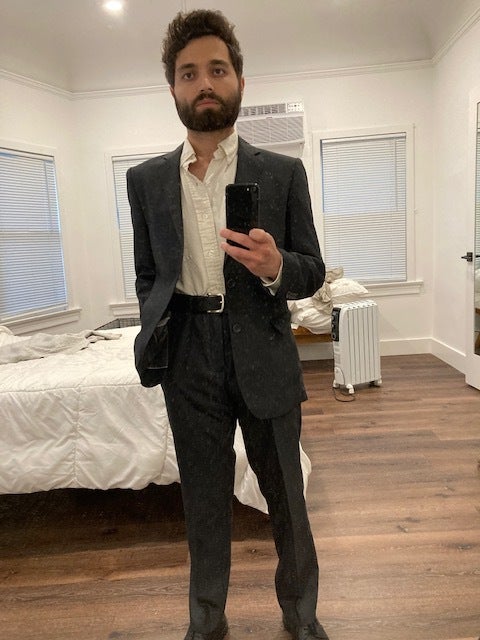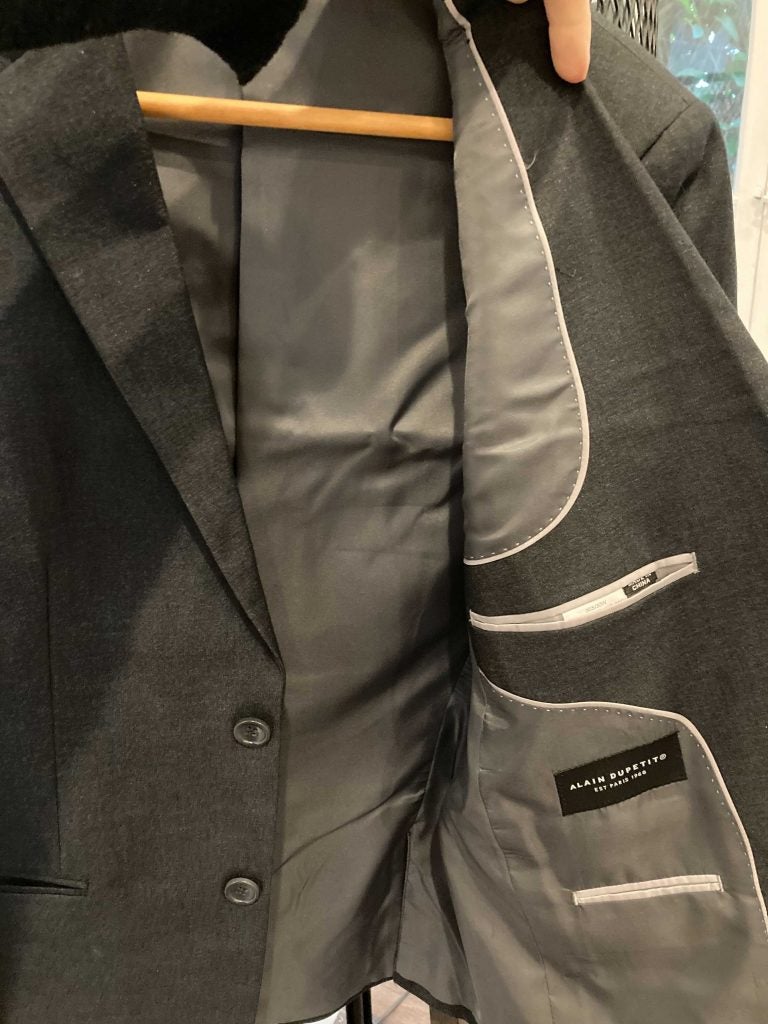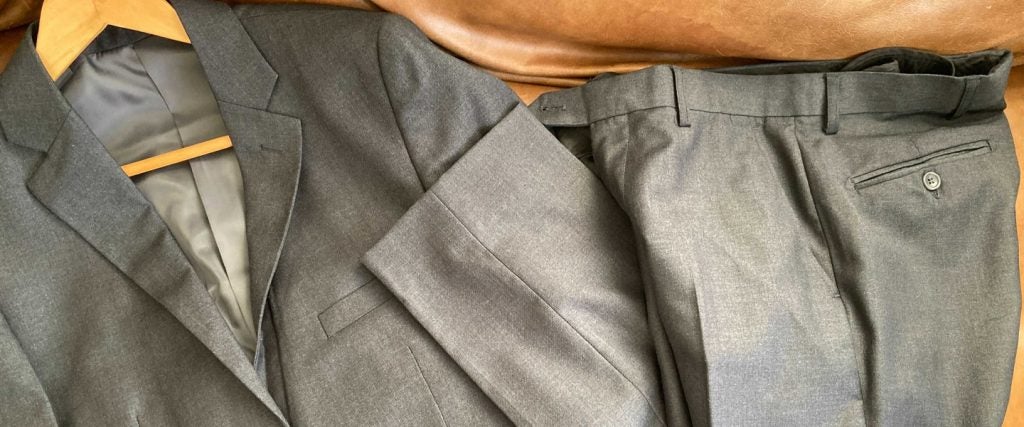I’m standing in front of the full-length mirror in my bedroom, attempting to get a good look at my new charcoal gray suit. I shove my hands into the pockets of the pants, before removing them and pulling the bottom of the lapels of the jacket. The size of the jacket, at least per the width of the shoulders, feels right. But I get this sense, after each glance in the mirror, that something is off. Fastening the top plastic button of the jacket — that’s already sort of loose — I wonder how long it will last before it’s hanging by a thread. On the inside, where my arms are encased in what feels like smooth plastic bags, the stitching scratches against my skin, especially when I lift my arms above my shoulders.
Yet, considering the price — 64 whole dollars — the suit looks good. That’s right, I’m in a cheap suit even by Men’s Wearhouse standards. Make that a very, very cheap suit. Case in point, this jacket — just the jacket — is $85 at Target. And pretty much every blazer at H&M retails for at least 70 bucks. I’m standing here, though, in a complete ensemble for six dollars less than that.
I found it — how else? — via a YouTube ad. The ad itself is far from a marketing triumph. The man in the video tugs on his suit jacket near where the buttons fasten together. Then he does a flip underwater. In fairness, it makes more sense with the tagline: “They make you feel like you’re floating.”
Despite the novelty of the low cost, a cheap suit is hardly a recent development. According to a 1987 New York Times article, by 1984, more than 80 percent of the suits sold annually had a retail price of less than $200, as it had already become too expensive for mid-tier brands to include hand-tailoring in their suits. Manufacturers like Brooks Brothers had reduced production time to a matter of hours through automation and the fusing of cloth — a process in which heat and resin, instead of hand stitches, were used to secure the interfacing that gives the front of a suit jacket its signature shape. Meanwhile, wool, the primary material used to construct a suit for years, was swapped out for less expensive fabrics like polyester.
In the case of my $64 Alain Dupetit suit, the fabric is a blend of rayon and tetron, a synthetic material similar to wool. It’s made in China, of course, but like any dropshipping company, its headquarters are elsewhere. In this case, none other than the couture capital of the world — Paris.
As for my personal suit history, in lieu of a proper suit, my closet has always been a mishmash of orphan jackets and standalone pants that never quite congeal. The result is an unassailable feeling that no matter how hard I try, my formal attire always feels asynchronous. Which is why I was interested in what Alain Dupetit had to offer in the first place — I wanted to try out a snazzy matching getup without spending a ton of cash on it. But when the suit arrived, I was immediately disappointed. Instead of what appeared in the pictures like a classic charcoal gray, the fabric looked metallic. Worse yet, the lapels, which had multiple crease marks, reminded me of dog-eared pages in a book.

Nonetheless, I threw it on for dinner that night with my girlfriend. It didn’t go well. In fact, I couldn’t wait to rip the jacket off, letting out an audible sigh when I did. “Are you okay?” my girlfriend inquired. I lied and told her I just wasn’t used to wearing a suit.
But there was definitely something else at play, and so, a couple of days later, I paid a visit to Art Lewin, a master of bespoke suits here in L.A. Obviously, he’s biased — his wares are about 40 times as expensive as Alain Dupetit’s at about $2,500 — but he tells me that part of the discomfort I was feeling was due to how the jacket is stitched together. “Hand-stitched suits lend themselves to more give,” he explains. The threads connecting the sleeves to the rest of the suit are more or less springs, “and when they’re hand-stitched, they’re slightly looser,” as opposed to when they’re stitched by a machine. “That’s why,” he informs me, “you feel like you can’t move.”

It doesn’t help either that the panels of the jacket are fused together. “That’s why it doesn’t drape,” he says. “If a suit feels papery,” Lewin adds, raising the front panel to my ear and grabbing the fabric behind it so I can hear the sound when he pulls the panels apart, “that’s because it’s glued together.” After taking a peek inside the jacket, he tells me that I’m essentially wearing a bunch of plastic.
But surprisingly, after Lewin takes the time to explain everything that’s wrong with my Alain Dupetit suit, he changes course. He says that despite its flaws, it’s no worse than any sub-$500 Hugo Boss or Giorgio Armani suit. “Those are also glued together,” he tells me. “A lot of them are made of polyester, too.” The primary difference is the cut. “Some of those suits will feel a bit more modern,” Lewin says. “This suit is a fairly standard, two-button suit.”
And so, here I am, in front of the mirror in my bedroom, giving my very cheap suit a second chance. All I really want is one moment where I catch a glimpse of myself and — just like George Zimmer promised in his Men’s Wearhouse commercials — I like the way I look. Needless to say, that feeling never really arrives — if anything, I couldn’t stop focusing on the one front pocket that was already kinda falling apart. But while the suit itself is uncomfortable, I find great comfort in the fact that what I have on isn’t all that different from a cut-rate Armani. Given that all of this is really about dollars and cents, that’s what makes me feel like a million bucks in the end.

